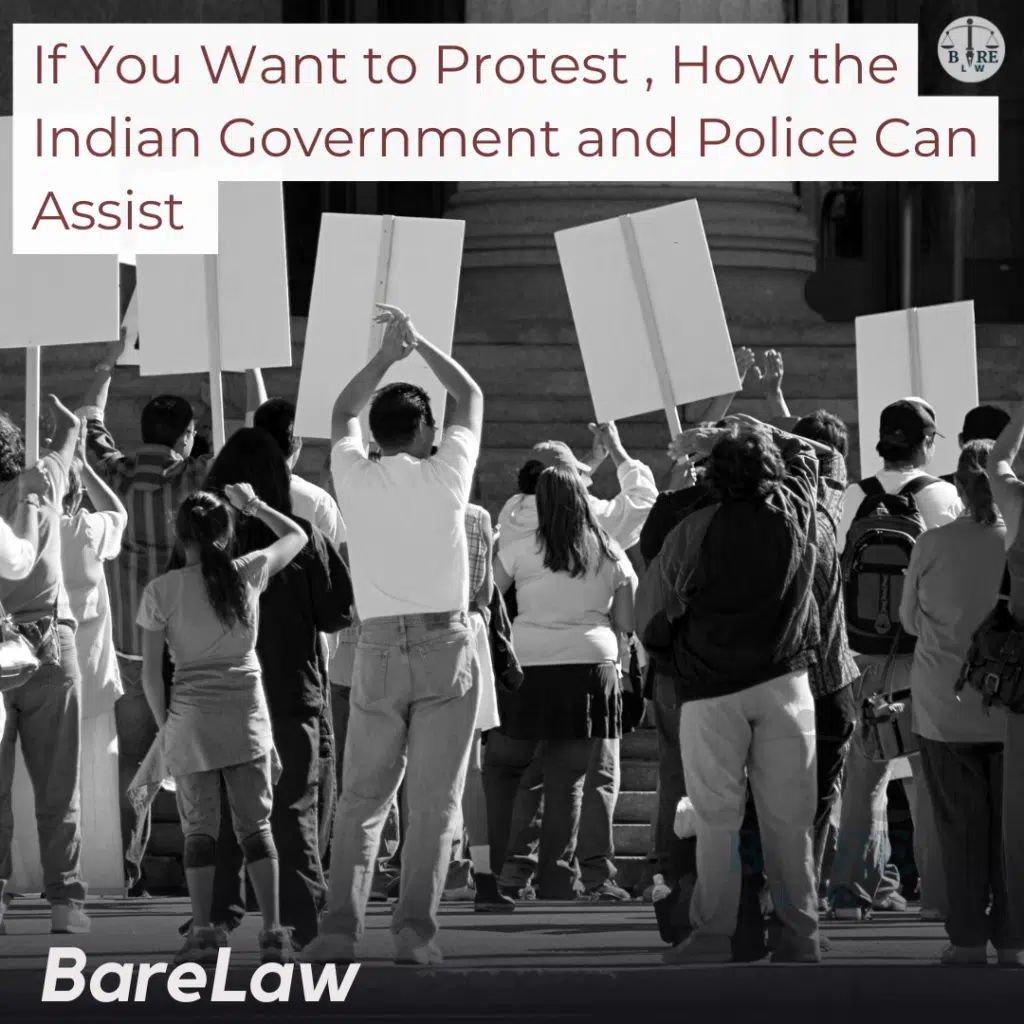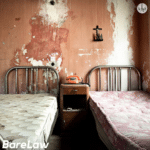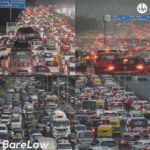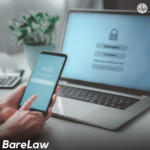
How the Indian Government and Police Can Assist You If You Want to Protest
Synopsis
In India, the right to protest is a constitutional guarantee under Article 19(1)(a) (freedom of speech) and Article 19(1)(b) (right to assemble peacefully). However, organizing a protest requires following legal procedures to ensure public safety and order. The police and government authorities play a vital role in regulating protests, granting permissions, and maintaining peace. In cases where permission is denied, citizens can seek legal recourse by filing a petition in court to protect their fundamental rights. Understanding how to work with the authorities and the legal framework around protests is essential for ensuring that your voice is heard while adhering to the law.
Citizens making their own voices heard and demanding accountability of Govt, through protesting or peaceful assembly is a must in a Democracy. The Constitution of India recognizes the right to protest under Article 19(1)(a) (the right to freedom of speech) and Article 19(1)(b) (the right to assemble peacefully); and without arms. Yet these rights are basic, and it’s important to note how the Indian government and police can support peaceful protests and the legal requirements for staging a demonstration.
Understanding Your Constitutional Rights
India’s Constitution provides freedom of speech and expression and allows for forming associations or unions, including political parties. These rights are not absolute, however. Protest regulation within public order, security or integrity of the state under the authority of the state government and law enforcement is warranted. While this regulation is necessary, this registration can sometimes be viewed as restrictive, as protests are sometimes refused permission or activists are detained.
1. Article 19(1)(a): Freedom of Speech
This article guarantees citizens the right to express their opinions freely through all manner of communication, including protests. However, such freedom is subject to reasonable restrictions in the interests of maintaining public order, security, and India’s sovereignty.
2. Article 19(1)(b): Right to Assemble Peacefully
A peaceful gathering of citizens displaying their emotions and holding public demonstrations is a citizen’s right. However, again, reasonable restrictions imposed on the assembly by the government are imposed to protect the public’s peace, disrupt public peace, or harm others.
Role of Police and the Government in Facilitating Protests
So, during protests, the police and local government authorities maintain law and order. Peaceful protest and safeguarding the rights of protesters and the public at large are all their responsibilities. Here’s how the government and police can assist if you plan to organize a peaceful protest:
1. Requesting Permission for a Protest
The first order of business is to oblige the local authorities and police, for instance, for permission before organizing a protest. Usually, a process where an application outlining what the protest is for, how many people will take part and where the protest will happen is submitted. For instance, in the recent case of Apex Body Leh vs. Govt. of NCT of Delhi, Ladakh activist Sonam Wangchuk and others wanted to protest at Jantar Mantar, a frequented protest site in Delhi. But the Delhi Police refused to let them go as it had some concerns.
- How to Apply for Permission: You can send a formal request to the police commissioner’s office or the district magistrate. For example, this is information about the protest: dates it was held, location, and number of attendees to the protest. Ensure the protest is meant to achieve an obvious goal and is legal to assemble.
2. Alternative Venues for Protests
The police will suggest alternative locations if the requested venue is unavailable or unsuitable for public safety or security concerns. Only in the case of Wangchuk’s protest did the Delhi Police deny permission for a protest at Jantar Mantar, and the petitioners contended that the police could have accommodated the protest at an alternative site.
- What You Can Do: If your initial request for a specific location is not granted, inquire with protestors if the protest can be relocated to another location that protects public safety while not restricting the right to assemble. Courts have urged the authorities to balance the rights to protest and public safety.
3. Ensuring Public Safety and Security
The police are also responsible for organizing protests, ensuring that the event does not create unrest, chaos, or violence. Depending on whether the protest is going to attract large numbers or whether it concerns a delicate issue, the police will send personnel to ensure a smooth protest and avoid any incidents between the protesters and counterprotesters.
- How the Police Help: They can erect barricades, judge when traffic is permissible, and control crowds. Besides, they ensure that the protest doesn’t get out of hand and leads to violence in the interest of both the protestors and the public. To conduct a peaceful and successful protest, you need to cooperate with law enforcement.
4. Legal Recourse if Permission is Denied
When people are not allowed to protest (by the police or government authorities), they can go to court. The Apex Body Leh case showed how the petitioners went to the Delhi High Court, arguing that the police’s denial of peaceful assembly violated their fundamental rights.
- What You Can Do: You can file a petition in the High Court if there was a denial of permission to protest on the grounds of violating your constitutional rights. The tension between the petitioners’ right to protest and the state’s interests in public safety and order is brought before the courts.
5. Adhering to Legal Obligations
We have to ensure their protest is within the law. The organizers may suffer legal consequences, and violent protests can result in arrests. Authorities can detain protesters if they believe the protest threatens security, as with the detention of Sonam Wangchuk and others travelling to Delhi from the Singhu Border.
- Protester Responsibilities: Organizers should ensure that the protest is peaceful and that people running it know what they can and can’t do within the law. They should also coordinate more closely and provide more services to law enforcement to ensure that there are no unnecessary conflicts or disruptions.
Legal Recourse and Judicial Intervention
The judicial system is crucial in protecting citizens’ rights to protest. Where the government or the police deny permission for the public to peacefully protest, courts frequently intervene without good reason.
- Public Interest Litigation (PIL): Citizens can file a PIL if they believe their constitutional rights are being violated due to the denial of the right to protest. Courts typically encourage the authorities to facilitate peaceful protests while ensuring public safety.
- Fundamental Rights Protections: The court may overturn the police’s decision if it finds that the denial violates Articles 19(1)(a) and 19(1)(b) of the Constitution. In such cases, the court can instruct authorities to allow the protest or provide an alternative arrangement.
Conclusion
Peaceful protests are perfectly legitimate expressions of peaceful agitation and common civic engagement in a democratic nation like India. Protesting is a constitutionally protected right, but laws restrict this right so that there’s public order and safety. If you are planning to protest, carry out legal procedures, get permission to conduct the protest and work with local authorities to make your protest peaceful.
Remember: If your request to protest was denied you have rights and petition the courts for protection. You can protect your rights and make your voice heard if you know what a police officer’s role is, and know your constitutional rights.
FAQs: Peaceful Protests in India – Your Rights and Responsibilities
1. What are my rights regarding protests in India?
As per the Indian Constitution, Article 19(1)(a) guarantees freedom of speech and expression, while Article 19(1)(b) allows the right to assemble peacefully without arms. These rights are fundamental, but subject to reasonable restrictions for maintaining public order and safety.
2. How do I get permission to organize a protest?
You must submit a formal request to local authorities, such as the police or district magistrate, outlining the purpose of the protest, the expected crowd size, and the proposed location. The authorities will review the application and either grant permission or suggest an alternative location if necessary.
3. What can I do if the police deny permission for my protest?
If the police deny permission, you can file a petition in the High Court challenging their decision. The court may instruct the authorities to reconsider or provide an alternative arrangement if the denial infringes on your constitutional rights.
4. Can the police suggest an alternative venue for the protest?
If the original venue poses public safety risks, the police can suggest an alternative location. Cooperation with the authorities can help ensure a peaceful and successful protest.
5. What are the legal responsibilities of protesters?
Protesters must ensure that the assembly remains peaceful and does not disrupt public order. Participants may face legal consequences, including arrest if the protest turns violent or unlawful.
6. What legal actions can I take if I feel my rights are violated during a protest?
You can file a Public Interest Litigation (PIL) or individual court petition if you believe your rights to freedom of speech and peaceful assembly have been violated. The courts often step in to balance the rights of protesters with the need for public safety.
7. How can the police help ensure a peaceful protest?
The police provide crowd control, enforce traffic regulations, and set up barricades to ensure the protest proceeds without violence. Working with law enforcement ensures the safety of both protesters and the public.
8. Can I protest anywhere in India?
While you have the right to assemble, protests in certain areas may be restricted for reasons such as public safety or security concerns. Always seek permission from local authorities before organizing a protest.



